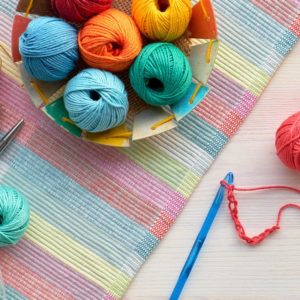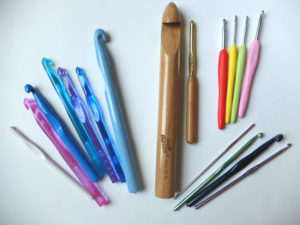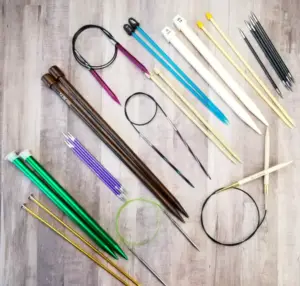Knitting Vs Crocheting
Jump To:
Knitting and crocheting are yarn crafts that employ yarn and stick-like tools to make a range of household goods, apparel, and accessories, so it’s no surprise that they’re frequently confused. So, what’s knitting vs crochet? Let’s look at the similarities and differences between knitting and crocheting along with some crocheting tips and tricks.

Similarities Between Knitting and Crochet
Knitting and crochet have a lot in common, despite their appearances.
- Both are little crafts that require yarn and a crochet hook or needles to complete.
- Both allow you to make various items with just basic stitches.
- Stitches and stitch combinations are described using particular terms and abbreviations in both crochet and knitting.
- Both employ patterns to explain the process of creating a given project.
- Crochet and knitting are both low-cost activities that may be begun right away.
- Both employ gauges to ensure that the final item is the right size.
- Knitting and crocheting are both enjoyable activities with several advantages.
- Both crafts use a range of yarns to make a variety of products.
- Both use stitch markers to identify an actual location in the project.
- They are both yarn-based crafts in which yarn is used to make the item’s fabric.
Crocheting Tools
Crochet and knitting vary primarily in that crochet use only one tool, a crochet hook, to generate loops and stitches and how those crochet stitches are employed to create the “fabric” of crocheted goods.
Crochet hooks exist in various lengths, forms, and thicknesses, but the most common crochet hook is a stick that is approximately 6-8 inches long and has a rounded curve/hook on one end. The head or tip of the hook is the name given to this curve.

Crochet Stitches
Crochet employs a diverse range of stitches. There are a few fundamental stitches that, if learned, can cover almost all of your crochet, at least at first. The following are the fundamental stitches used in a wide range of crochet projects. Here are beginner crochet stitches in detail with steps.
- Slip knot
- Chain stitch
- Slip stitch
- Single crochet
- Half double crochet
- Double crochet
You may make entire projects with only one stitch and have them look fantastic, or you can use a new stitch in each row.
Fabric
Crochet fabric may range from highly thick and tight (as in amigurumi toys) to very loose and lacy (as in doilies and elaborate shawls) and everything in between. Crochet fabrics are often heavier and stiffer than knit fabrics.
Number of loops
Crochet is done one loop at a time and provides a range of pivoting options in the pattern, allowing for the concealment of any miscalculations or mistakes and the concealment of ends and yarn join. Because crochet materials work with only one loop on the hook at a time, it’s simple to remove the hook, set a stitch marker to designate the spot, and put your work aside. Because a single hook isn’t “trapped” in your project, you may use it in many projects simultaneously.
Knitting Tools
Knitting, unlike crochet, creates cloth with two (or more) needles. These needles come in a variety of shapes and sizes:
- a mix of short and lengthy.
- With a needle-like tip on both ends, it’s double-sided.
- Needles have a tip on one side and a little ball or cube on the other to keep your knitting from falling off and unraveling.
- Circular needles let you work on huge or circular projects by connecting two needles with a plastic tube or cable.
A loom is another tool for knitting. Loom knitting is a simple technique to learn how to knit, and it is popular among children. A knitting machine is another option for knitting simple objects, mainly where speed and consistency of stitch quality are essential.

Knitting Stitches
Knitting is made up of only a few fundamental stitches:
One can use these fundamental knit stitches to make a knitting object. Specific knitting patterns only employ one stitch type (knit stitches or just purl stitches).
Knitting stitches such as yarn over (YO) and knit two together (K2TOG) are constructed on the foundation of fundamental stitches.
Fabric
Knitted fabric is denser and more even than crochet cloth, with fewer holes and voids. This fabric has a crisp, even appearance and drapes beautifully, mainly when using smoother, silkier yarns.
Speed
It takes longer for the knitted fabric to expand since the loops are smaller and closer together. Knitting is slower than crocheting in general unless you master a speed knitting method like Russian Continental. You can knit quickly without looking at your work, which is more challenging to accomplish in crochet.
Number of loops
Knitting is done in several loops (also known as active loops or live loops) at once, requiring you to have as many loops on your needles as the width of the knitted product.
When you don’t have much experience, this might cause problems, such as:
- having too many or too few loops for the end product, and having to repeat the item from the beginning.
- a needle slipping out of your live work and dropping the stitches, causing the work to unravel
- It’s more difficult to conceal and weave in yarn ends without them being seen.
Crochet And Knitting
Each craft technique has its benefits and drawbacks, often producing fabric unique to that craft alone. However, there are ways to “fake” the knitted look with crochet and vice versa, so if you like one but not the other, don’t despair; you can often replicate the look you want with the tools you already have.
Despite their fundamental differences, both crochet and knitting provide the convenience of a craft that is portable, requires a minimal number of tools, is relatively inexpensive to learn, can be taken on the go, is not noisy or smelly, does not require electricity to operate, and uses yarn as a medium, which is a huge advantage!
Give both crochet and knitting a try to determine whether they’re right for you. Some individuals swear by crochet and never use knitting needles. In contrast, others start with crochet and find knitting much simpler to master after that, eventually switching back and forth between the two. Try both of these fantastic tasks and determine which one you prefer.
Is it easier to learn to knit or crochet?
Crocheting is easier than knitting once you’ve learned the fundamentals since you don’t have to move the stitches back and forth between needles. Crocheting is less prone than knitting to unravel by accident.
Is crocheting better than knitting?
Crochet takes less time to make than knitting. Knit sweaters, afghans, cushions, and a variety of modest, simple crafts. Because crochet only has one live stitch, it allows you to make more fascinating multidirectional items like granny squares, amigurumi, and yarn bombing.
Why is knitting so hard?
Knitting isn’t tricky, but it does take some practice. As you’ll find after the first time you take up knitting needles, your muscles and mind require time to acclimatize to the new actions. Knitting stitches evenly over the entire item will also take a lot of skill.
Is Crochet an Affordable Hobby?
The short answer: yes. At least, it’s as affordable as you want it to be. High-end yarns can get pricey, but you don’t necessarily need them; you can crochet with free materials such as cut-up plastic bags, or recycled materials such as fabric strips cut from old clothes or linens.
Is crocheting more popular than knitting?
Crochet objects to make them appear more like knitting (like ribbing) or create motifs and stitches that you wouldn’t be able to achieve while knitting. Crocheting is likely to be the more popular option with those considerations in mind.
Is knitting or crocheting older?
Knitted textiles survive from as early as the 11th century CE, but the first substantive evidence of crocheted fabric emerges in Europe during the 19th century.
Is crocheting good for your brain?
By the time you’ve finished reading this blog post, you may find this factoid less surprising. Still, knitting and crocheting benefit the brain by exercising and improving your memory. Yarn crafts force your brain to actively use and rely on its memory centers, while being enjoyable and not laborious.